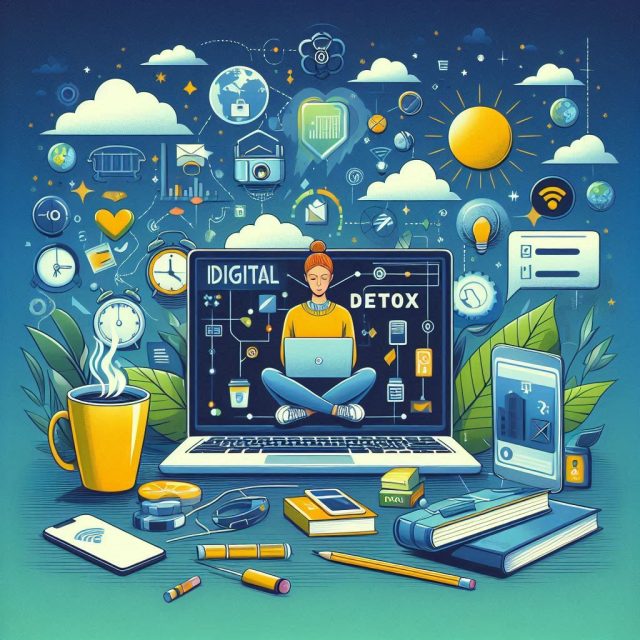The Need for a Digital Detox
In today’s fast-paced world, our smartphones, computers, and other digital devices are integral to our lives. While technology offers immense benefits, the constant barrage of notifications, emails, and social media updates can lead to digital overload. This constant connectivity can affect our mental health, productivity, and personal relationships. Recognizing the need for a break from screens can be the first step towards reclaiming our time and mental well-being.
What Is a Digital Detox?
A digital detox involves temporarily unplugging from digital devices to reduce stress and regain control over one’s time and attention. It is not just about reducing screen time but also about re-evaluating how and why we use technology. A successful digital detox helps individuals reconnect with themselves and the world around them, fostering a healthier relationship with technology.
Signs You Might Need a Digital Detox
- Increased Stress and Anxiety: You may feel overwhelmed by the constant influx of information and notifications. This can lead to a heightened sense of anxiety and stress.
- Poor Sleep Quality: If you’re experiencing trouble falling asleep or staying asleep, it might be due to the blue light emitted by screens or engaging in stimulating activities before bed.
- Reduced Productivity: Frequent distractions from digital devices can hinder your ability to focus on tasks, leading to procrastination and decreased productivity.
- Neglecting Personal Relationships: Spending excessive time online can detract from face-to-face interactions, weakening personal relationships and social connections.
Benefits of a Digital Detox
- Improved Mental Health: Disconnecting from screens can lead to lower levels of stress and anxiety, enhancing overall mental well-being. A break from constant notifications can give your mind the space to relax and rejuvenate.
- Enhanced Productivity: By reducing distractions, you can improve your focus and efficiency. A clear mind and fewer interruptions can lead to better performance in both personal and professional tasks.
- Better Sleep: Limiting screen time, especially before bed, can improve your sleep quality. Reducing exposure to blue light helps regulate your sleep-wake cycle, making it easier to fall asleep and stay asleep.
- Strengthened Relationships: Spending more time offline allows you to engage more meaningfully with family and friends, leading to stronger and more fulfilling personal relationships.
Unplug to Recharge: Embrace the Digital Detox
How to Implement a Digital Detox
- Set Clear Goals: Decide on the scope and duration of your detox. Whether it’s a full day without screens or a weekly tech-free evening, setting specific goals will help you stay committed.
- Create Tech-Free Zones: Designate areas in your home where screens are not allowed, such as the dining table or bedroom. This can help create a space for relaxation and real-world interactions.
- Schedule Breaks: Plan specific times during the day to check your emails and social media. By limiting your digital engagement to these times, you can avoid constant interruptions and maintain focus.
- Engage in Offline Activities: Rediscover activities that don’t involve screens. Reading physical books, cooking, gardening, or exercising are great ways to spend time without digital distractions.
- Use Technology Mindfully: When you do use technology, be intentional about it. Focus on activities that add value to your life, such as learning a new skill or connecting with loved ones.
Challenges and Solutions
- FOMO (Fear of Missing Out): It’s natural to worry about missing out on updates or events. To manage this, remind yourself of the benefits of the detox and the value of being present in the moment.
- Work Commitments: For those whose work relies heavily on digital tools, schedule specific times to address work-related tasks. Use tools like “Do Not Disturb” modes to minimize interruptions during your detox period.
- Family and Social Expectations: Communicate your detox plans with family and friends. Explain the reasons behind your decision and suggest alternative ways to stay connected during your break.
Long-Term Strategies for Healthy Technology Use
- Mindful Consumption: Be intentional about your digital consumption. Choose quality content that enriches your life and avoid mindless scrolling through social media.
- Tech-Free Times: Incorporate regular tech-free periods into your daily routine. For example, designate an hour each evening to unplug and focus on non-digital activities.
- Digital Boundaries: Set clear boundaries for when and where technology can be used. For instance, avoid checking emails or social media during meals or before bedtime.
Conclusion: Embracing a Balanced Approach
Embracing a digital detox is not about rejecting technology but about finding a balance that works for you. By taking intentional breaks from screens, you can enhance your mental health, boost productivity, and strengthen personal relationships. Start with small, manageable changes and gradually incorporate more tech-free practices into your daily life. A balanced approach to technology use can lead to a more fulfilling and present life.
Less Click, More Connection: Embrace Real Moments
Additional Resources
- Books and Articles: Consider recommending books like “Digital Minimalism” by Cal Newport or “The Shallows: What the Internet Is Doing to Our Brains” by Nicholas Carr for further reading on digital wellness.
- Apps for Digital Detox: Suggest apps that help manage screen time, such as “Forest,” which encourages you to stay off your phone by growing virtual trees, or “Moment,” which tracks and limits your screen time.






